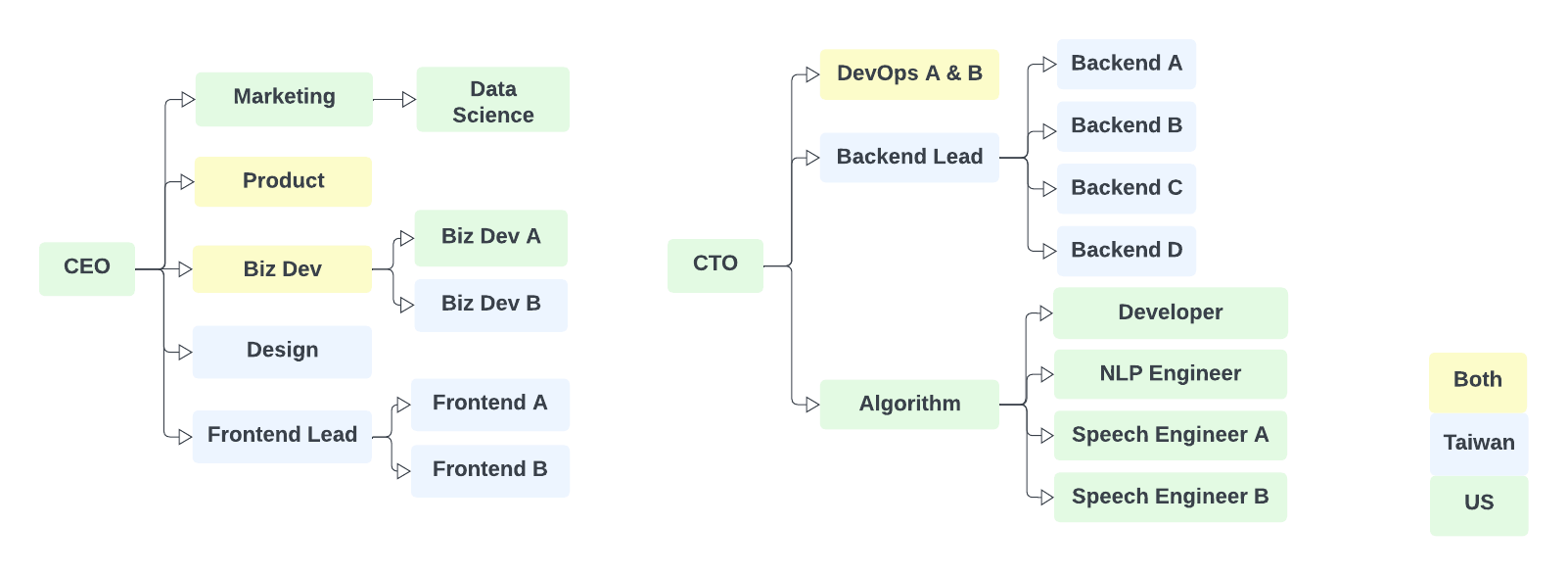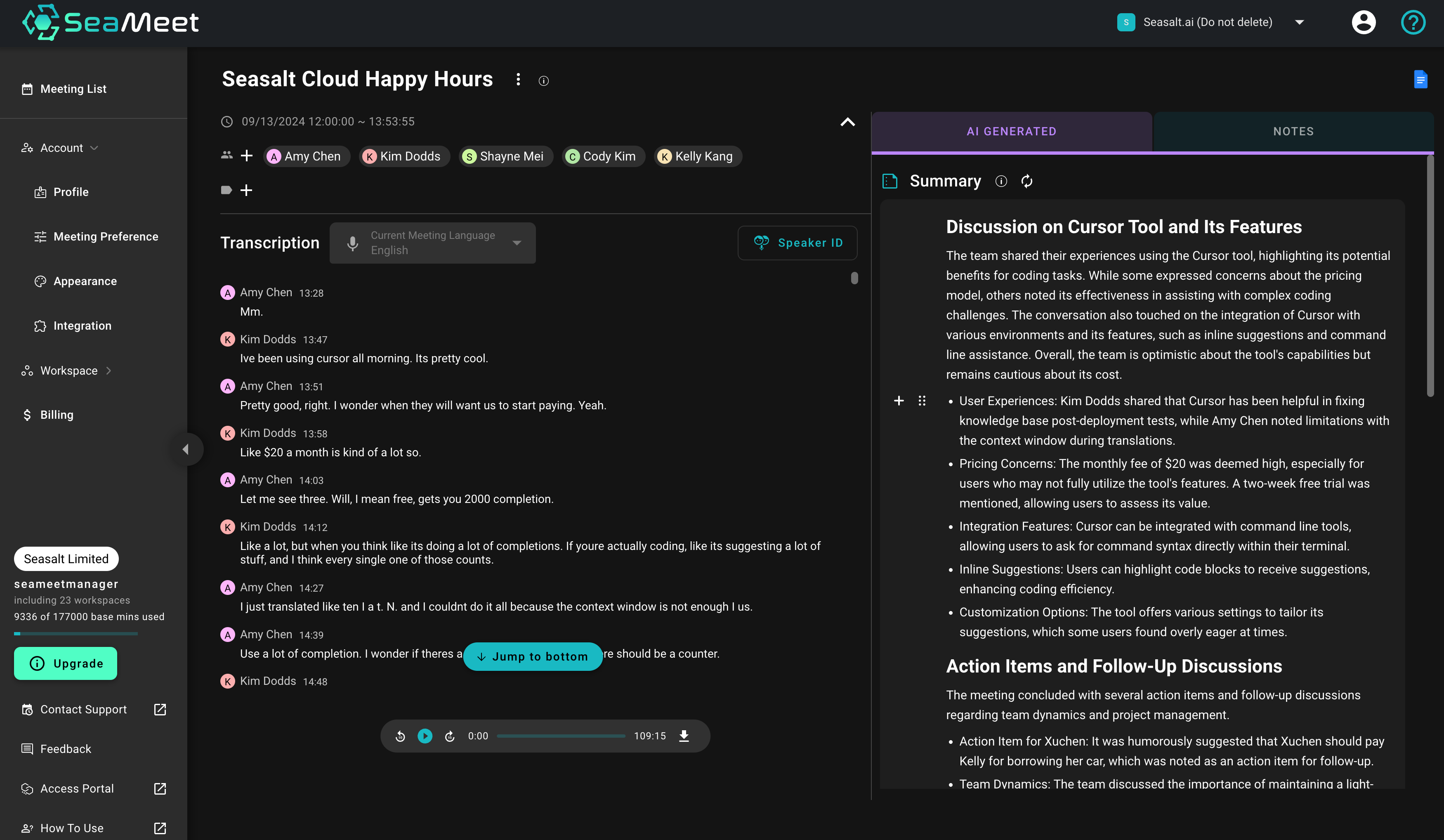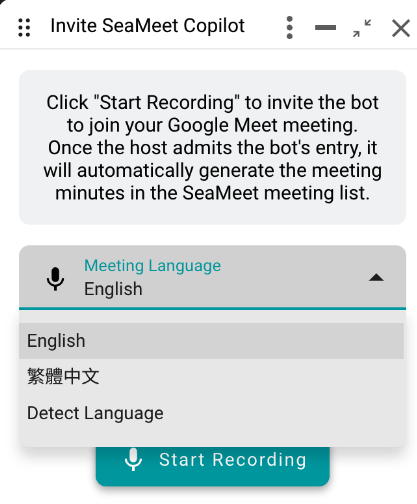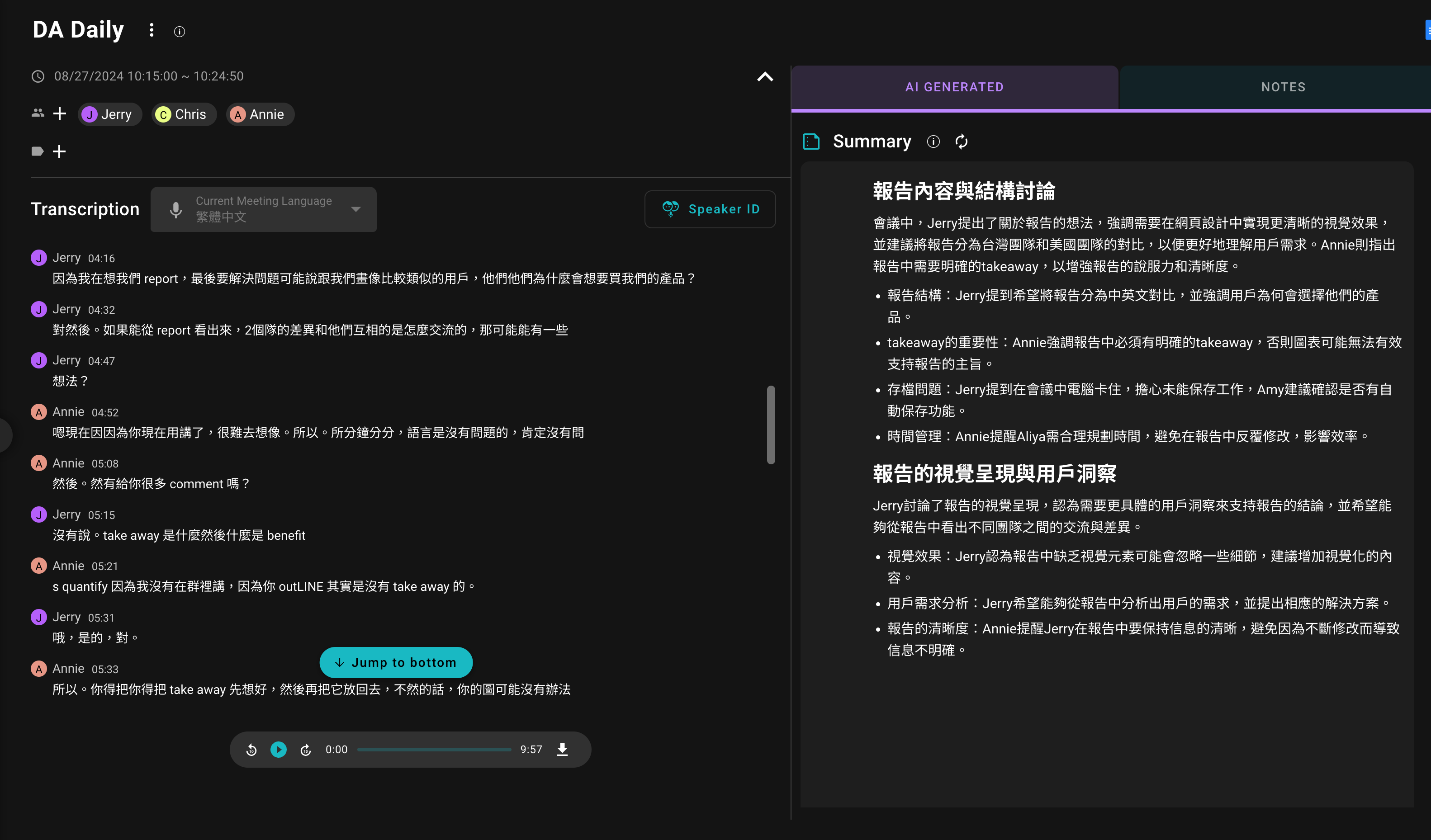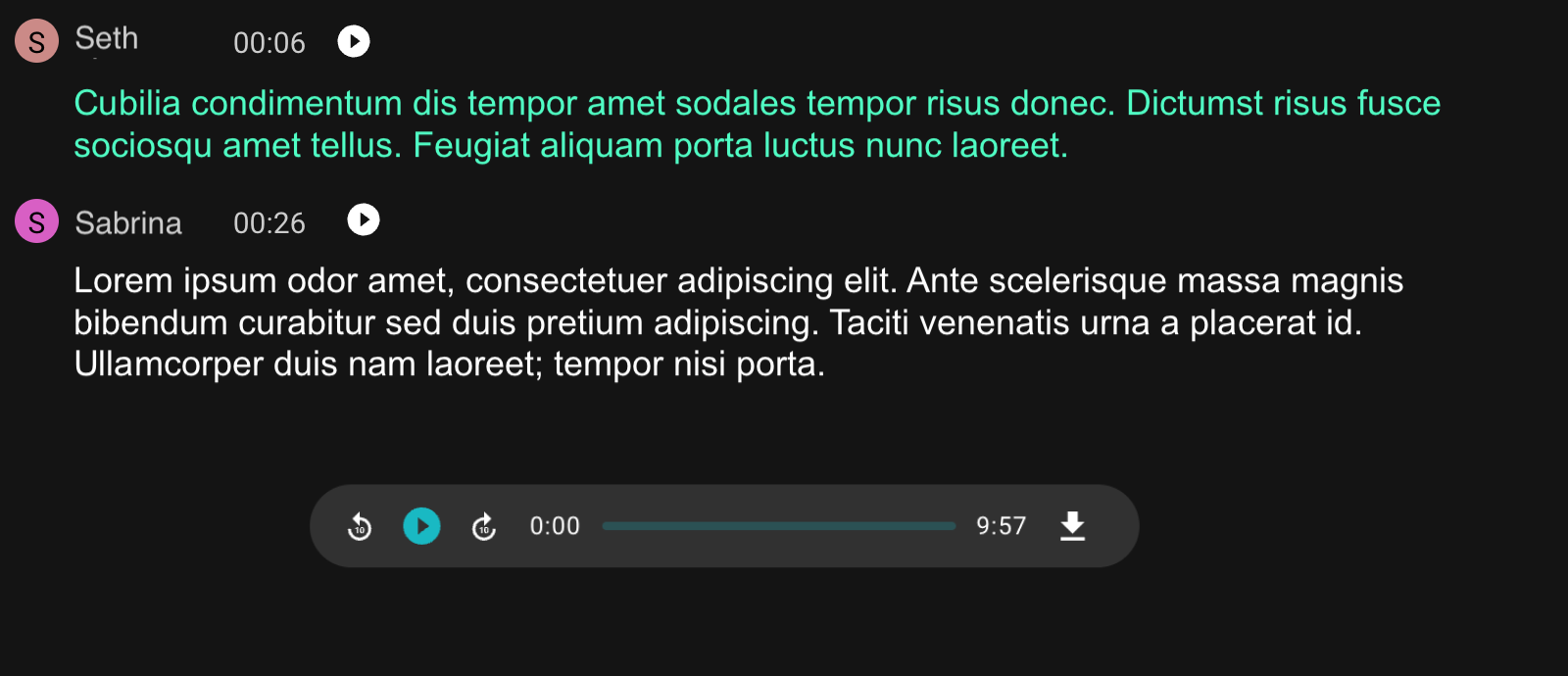How to Use SeaMeet to Manage a Global Team
SeaMeet solves top 3 challenges of managing remote teams -- time zone differences, cultural barriers, and lack of team visibility.
View Audio Transcription
Mandy: Managing a global team. Sometimes it feels like you're juggling time zones more than anything else.
Jeff: It's a common struggle. Well.
Mandy: Today we're looking at GlobalSync IO. They're tackling this head on using an AI tool called SeaMeet.
Jeff: Interesting. I've heard of SeaMeet.
Mandy: It's like having a 24/7 assistant specifically for your global team.
Jeff: Ambitious.
Mandy: We're talking time zones, cultural differences, the whole work.
Jeff: Those are big ones.
Mandy: Huge. And we've got excerpts from their experience using SeaMeet, claiming it cracks the top three challenges of managing remote teams.
Jeff: Which if true, could be a game changer. What were the specific challenges GlobalSync IO was facing?
Mandy: So picture this. They've got teams in Silicon Valley.
Jeff: Okay, standard tech hub.
Mandy: Exactly. And Taiwan.
Jeff: So right away, you've got that time difference.
Mandy: Oh, it's brutal. Plus all the complexities of communication across cultures, not just the time zones, but that feeling of, you know, are we even on the same page?
Jeff: That lack of being in sync, it's a real productivity killer.
Mandy: Totally. It's not just inconvenience. It's like we create an environment where everyone can actually do their best work?
Jeff: Absolutely.
Mandy: So they call themselves a meeting co pilot, which I'll be honest, I immediately imagined a little robot sidekick.
Jeff: I mean, the visual is strong, right? But in all seriousness, what does that actually mean in practice?
Mandy: It's designed to assist with meetings, especially in this global context, taking notes, translating languages on the fly and keeping everyone in the loop, time zones be darned.
Jeff: That's addressing a real pain point. Yeah, but how well does it work in reality?
Mandy: Let's dive into the specifics, starting with time zones, the ultimate enemy. The case study highlights how GlobalSync IO practically eliminated those late night, early morning meetings using SeaMeet.
Jeff: Now that's a win. I think we can all get behind how they manage that.
Mandy: One way is through selective participation.
Jeff: Sounds intriguing. So not everyone has to be at every meeting.
Mandy: You are picking up what I'm putting down. You might not attend live, but you're still in the loop.
Jeff: How does that actually work?
Mandy: So SeaMeet can in a way attend for you, taking detailed notes, catching all the key decisions, even creating summaries tailored to your needs.
Jeff: Like a personal meeting secretary powered by AI. That's impressive.
Mandy: Right? And this all ties into how they keep everyone on track across those time zones.
Jeff: Okay, I see we're going with this. So someone misses a meeting because they're in, say, a completely different time zone. Happens all the time. And instead of having to dig through hours of recordings or way through pages of minutes, they can get a quick but comprehensive summary from SeaMeet.
Mandy: Exactly. And this directly addresses that disconnect GlobalSync IO was feeling between, say, they're Silicon Valley and Taiwan teams. Everyone's on the same page no matter when they log in.
Jeff: It's like a global team equalizer, at least when it comes to information. Yeah, I like it. But we've only tackled one challenge so far. What about communication across cultures?
Mandy: That's a whole other beast. We all know how even a small miscommunication can spiral out of control.
Jeff: Especially in a global business context.
Mandy: Exactly. And this is where SeaMeet's real time transcription comes in. And we're not just talking English to Spanish here. No.
Jeff: Even more impressive.
Mandy: We're talking automatic detection and transcription of multiple languages, including crucially for GlobalSync IO, Mandarin.
Jeff: So their Taiwan team could literally have meetings in Mandarin.
Mandy: You got it. And SeaMeet made sure everyone else understood no matter what language they spoke.
Jeff: That removes a significant barrier for non native English speakers.
Mandy: The case study even mentioned a developer in Taiwan saying that having those real time subtitles, even though English wasn't their first language, it made them more confident participating in meetings.
Jeff: That's fantastic. It's not just about understanding the words. It's about feeling included.
Mandy: Creating a space where everyone feels comfortable contributing their ideas.
Jeff: Exactly. And that, I think, gets to the heart of what makes managing global teams so challenging. It's about building that sense of trust and understanding across cultures.
Mandy: Building bridges, not walls.
Jeff: Exactly. But we still got one more challenge to tackle, right? That feeling of not really knowing what your team on the other side of the world is doing day to day.
Mandy: That's a big one. And this is where it gets really futuristic. SeaMeet claims to provide insights into how your team functions. Like, here's the data on your team.
Jeff: Dynamic data driven insights into teamwork. That peaks my interest. How do they pull that off? It's all about the data. They take everything, transcripts, who attended, what, even get this sentiment analysis.
Mandy: Like they can tell if a meeting went well based on people's vibes.
Jeff: That's the idea. It's all about painting a picture of how teams actually function, not just what tasks they're checking off.
Mandy: So going beyond just capturing information to actually understanding it using that data.
Jeff: To provide actionable insights. Yeah, managers can see who the key communicators are, what topics are causing a buzz, even if there are any communication silos happening.
Mandy: Communication silos, those are.
Jeff: Death traps for productivity truth.
Mandy: But if you can spot them early.
Jeff: Exactly. Or imagine you're a manager and you wanna identify emerging leaders within a team, SeaMeet could potentially highlight those who are already stepping up communication wise.
Mandy: So instead of just going with your gut, you've got data backing it up.
Jeff: Precisely. It's about empowering managers with information so they can make better decisions about how their teams collaborate.
Mandy: All right, so much time pack here, but we've got to ask, is it all sunshine and roses? Are there any potential downsides to this level of, let's be honest, surveillance?
Jeff: That's the million dollar question, isn't it? Yeah, because the potential benefits are huge, but the ethical implications, we can't ignore those.
Mandy: All right, so let's talk ethics. What are the red flags we should be watching out for?
Jeff: Transparency is key. Teams need to know what data is being collected, how it's being used, the whole nine yards. No one wants to feel like they're being spied on, right?
Mandy: That feeling a big brother is never a good look.
Jeff: Definitely not. It's a balancing act we want to use data to make teams better, but not at the expense of individual privacy and autonomy. It's like.
Mandy: Technology should be a tool, not a dictator.
Jeff: Well said. The human element that can't get lost in the shuffle.
Mandy: Right? Because at the end of the day, it's still humans working with humans, even with all this fancy AI in the mix. So we've covered a lot of ground here, time zones, cultural differences, even the wild world of team dynamics, all through the lens of SeaMeet.
Jeff: It's a fascinating case study and it raises a lot of important questions for anyone managing a global team.
Mandy: Because it's easy to get seduced by shiny new tech.
Jeff: But the real question is, does it actually solve the problems you're facing? And just as importantly, is it the right fit for your team's culture?
Mandy: It's easy to think, oh, AI will magically fix everything, but it's really about finding those tools that actually work for the way your team operates.
Jeff: And not just the tools, but the whole approach, right? Yeah, AI can be powerful, but it's not a substitute for building a healthy team culture from the ground up.
Mandy: Hundred percent. It's more about asking ourselves, okay, what are the sticking points and how we're working now? Are we making things harder than they need to be?
Jeff: And if so, are there tools out there that can help us streamline things, make us more efficient?
Mandy: Exactly. But always with that critical on I, right? Are we using this tech responsibly?
Jeff: Because ultimately technology should be working for us, not the other way around.
Mandy: Right? We don't wanna become slaves to the robots, even if they are taking notes for us.
Jeff: Exactly. It's about finding that sweet spot where tech enhances our ability to connect and collaborate as humans. That's where the magic happens.
Mandy: Okay, so as we wrap up this SeaMeet deep dive, what are the key takeaways our listeners should keep in mind?
Jeff: Well, first off, let's acknowledge the challenges of managing global teams are real. It's not just a matter of sending a few emails and hoping for the best.
Mandy: Time zones, cultural differences, those communication breakdowns, they're not going away anytime.
Jeff: Soon. Exactly. But like we saw with GlobalSync IO, there are solutions out there, whether it's AI powered tools or simply creating a culture where open communication and just as important, empathy are valued.
Mandy: Being proactive, not just reactive. Absolutely. This whole case study got me thinking. The way we work is changing so rapidly. It's not just about where we do the work, it's about finding ways to work together no matter where we are in the world.
Jeff: And that's exciting because it opens up so many possibilities for who we can collaborate with.
Mandy: Tackle down those geographical barriers, tapping into a global talent pool.
Jeff: And it's a trend that I think we're only gonna see more of in the years to come.
Mandy: So as always, we wanna hear from you. What resonated with you about this deep dive into sea need? Are you facing similar challenges in your own work?
Jeff: Because let's face it, we're all in this together. The more we share our experiences, the more we can learn from each other.
Mandy: So keep exploring those ideas, keep asking those tough questions. And until next time, happy collaborating.
This is a SeaMeet customer story. In this case study, we delve into how SeaMeet, a meeting copilot, helped GlobalSync IO, a B2B SaaS company with teams in Silicon Valley and Taiwan, overcome the major challenges commonly faced by cross-lingual, cross-border teams.
Key Takeaways
Balance Time Zone Disparities
SeaMeet automatically joins meetings and shares meeting notes for the entire team, so no one will miss important information during sleep.
Better Intercultural Communication
SeaMeet records meetings in real-time, allowing intercultural team members to easily follow along, replay, and review in English, Mandarin, other languages.
Insights about Team Dynamics
With SeaMeet data, you’ll always have rich insights about the cross-border teams' work dynamics and communication patterns.
So, you have a global team.
Hiring a global team seemed like the perfect solution for scaling your business. But now, you’re faced with unexpected hurdles:
time zone clashes
cultural differences
a constant feeling that you’re in the dark about what your team is actually working on
You are not alone.
These are the top issues that most business owners/founders face when managing global teams according to Decode, IntelliSoft, and Forbes.
SeaMeet eliminates frictions in global teams.
Before we dive in, you may be curious...
How to manage a team(s) in different time zones?
One of the biggest challenges for global teams is coordinating across time zones. Often, team members have to wake up early or stay up late to keep up with meetings. SeaMeet solves this problem by providing a 24/7 'company secretary' that automatically joins all meetings, records them, and shares comprehensive notes with the entire team. This ensures that no one misses important information, even while they’re asleep.
How to overcome cultural differences in teamwork?
Global teams often face cultural differences, such as accents or language preferences, that can hinder communication. SeaMeet addresses this by recording meetings in real-time, providing translations and subtitles in English, Mandarin, and other languages. This ensures all team members can follow along and review discussions, bridging language gaps effectively.
But, still, how do I know what my team is doing?
The hardest problem is still lack of transparency and structure. SeaMeet addresses these issues by providing clear insights into team dynamics. Founders frequently face difficulties in understanding how and when their team members interact. Key questions include: What are the current goals and priorities? Are team members engaging effectively? And who is communicating with whom?
SeaMeet’s Insights AI can help you answer these questions, enhancing your team’s clarity and transparency.
How much time/money does SeaMeet save for GlobalSync IO?
Meet GlobalSync IO
A 4-year-old startup that has teams in Silicon Valley and Taiwan.
Industry
B2B SaaS, Software
Company Size
20
Locations
Silicon Valley & Taiwan
GlobalSync IO is a B2B SaaS company with teams in Silicon Valley and Taiwan, working together to develop practical solutions. By operating across these two locations, GlobalSync IO makes the most of a 16-hour workday to extend business hours and support global operations.
However, the company faces typical challenges of offshore teams. Coordinating meetings across different time zones is difficult, and cultural differences can complicate asynchronous communication. The founder is determined to grasp the team dynamics and identify the key issues affecting collaboration.
He used SeaMeet to resolve these challenges.
GlobalSync IO's 16-Hour Work Day
Balanced Team Structure Across Two Locations
Similar to other innovation-driven startups, the team is highly technical, with 14 engineers and 6 non-engineers. The distribution is well-balanced between the two locations.
Small Team. Many Meetings.
By using SeaMeet to record every meeting, we are able to capture interesting meeting statistics at GlobalSync IO.
10meetings per workday | 36.6minutes average meeting length | 5participants per meeting |
Although the company is fully remote, the teams heavily rely on synchronous communication (meetings) to work together.
The chart below shows two distinct meeting peaks: one at 9 AM Taiwan time and the other at 9 AM Silicon Valley time. After each peak, the number of meetings declines, indicating a similar work pattern. Team members generally complete their meetings early in the day and then focus on development for the rest of the day.
The team's adoption of SeaMeet was gradual. Initially, SeaMeet wasn't used for all meetings. After the SeaMeet's Auto-join feature was introduced, GlobalSync IO quickly activated it to ensure no meeting is missed. The company wants to see the full picture of their meeting patterns.
The chart shows a sharp rise in tracked meeting minutes once the entire team enabled calendar integration and began using SeaMeet for every meeting.
1. SeaMeet Overcomes Time Zone Challenges
Time zone differences are a major challenge for global teams. With SeaMeet serving as a 24/7 "company secretary," GlobalSync IO's team no longer has to choose between staying up for late-night meetings or missing important discussions.
SeaMeet ensures that all meetings and updates are recorded and available to the entire team, keeping everyone aligned regardless of time zones.
Here are 3 ways how SeaMeet tackle communication gap caused by time zone differences:
Time Zone Challenges
How to Solve It
Need to stay up late for meetings
Cannot stay on top of decisions and work progress made during their sleep
Hard to trace project progress and stakeholders
Selective participation made possible by auto-join
Wake up to comprehensive meeting summaries and action items in your inbox
Act as your company knowledge base and project manager
1-1. Selective Participation
Perfect for handling early-morning, late-night, and conflicting meetings. Attend only the meetings that truly need your presence.
Unlike other meeting copilots that require your physical presence, SeaMeet handles meetings 24/7 on your behalf, making it ideal for cross-timezone teams and allowing you to focus only on meetings that truly need your presence.
With SeaMeet, the GlobalSync IO team—particularly C-level executives and product managers—can avoid staying up late for overseas team syncs. They can send SeaMeet to auto-join meetings and review the notes later -- as soon as they opened their email inbox next morning.
SeaMeet also resolves meeting conflicts and makes parallel meetings possible. For example, the CEO can attend one client meeting while sending SeaMeet to join the team sync.
1-2. Wake up to Insights
After every internal or external meeting, SeaMeet automatically sends an email to all participants with a summary, key action items, and discussion points. GlobalSync IO also chooses to CC the executive team, allowing the CEO and CTO to stay informed on decisions made during meetings.
This is particularly useful for asynchronous communication across time zones. Team members can start their day with insights from the previous night’s meeting and take action without worrying about missing important decisions or discussions that happened while they were offline.
1-3.All Meetings Tracked. All Knowledge Saved.
SeaMeet is a comprehensive meeting library designed to bridge time zone differences for cross-border teams. It allows teams to access and track all meetings with organized, hierarchical, and topic-focused summaries as well as action items.
By integrating SeaMeet, GlobalSync IO not only enhances its project management but also builds a robust company knowledge base just by using SeaMeet. Time zone barriers no longer impede access to latest important team updates.
2. SeaMeet Helps with Cross-border Communication
Cultural differences can challenge cross-border teams, but SeaMeet helps bridge these gaps with high-accuracy real-time transcription in dual languages and live subtitles that boost confidence for non-native speakers. These features ensure everyone can follow discussions and participate effectively.
SeaMeet also provides multilingual meeting summaries and replay options, allowing team members to quickly review and understand content. This approach maintains clarity and alignment, making communication smoother across diverse teams.
Here are 3 ways how SeaMeet tackle communication gap caused by cultural differences:
Cultural Difference Challenges
How to Solve It
Many teammates' first language is not English
Cross-border teams want meetings in their native language with a consistent note template
Miscommunication caused by cultural differences
Real-time transcription in dual languages settings
Multi-lingual support for meeting summaries and action items
Real-time subtitles and audio replay for clarity and review
2-1. Multilingual Transcription Support
Supports Mandarin, English, and other languages. Just let SeaMeet "detect language".
GlobalSync IO had been searching for a meeting co-pilot that supports both Mandarin and English equally well, but struggled to find one. When the founder discovered SeaMeet, it was the perfect solution.
With many GlobalSync IO team members being non-native English speakers, SeaMeet's real-time subtitles, audio playback, and meeting notes have made a big impact. Jane, a frontend developer in Taiwan, shared that SeaMeet "helps her communicate more confidently in meetings with the US."
SeaMeet tackles a common challenge in global teams—language and cultural barriers that can cause misunderstandings and slow collaboration. By offering clear, real-time subtitles, it reduces friction and ensures smoother communication.
2-2. Consistent Meeting Notes for All Languages
The Taiwan team prefers to hold meetings in Mandarin, their native language, when U.S. teammates are not present. However, they still want the same organized, hierarchical, and topic-focused summaries, along with action items in the same format used by the Silicon Valley team. This is a common challenge for global teams: non-English speakers often seek efficiency by forming private discussions in their native language, which can reduce overall team transparency.
SeaMeet bridges this communication gap by providing the same meeting copilot experience for both teams, regardless of language. Teams can hold meetings in their preferred language while maintaining consistent meeting notes across the board. The U.S. team can easily translate the text to stay informed. GlobalSync IO loves this feature, as it allows teams to freely discuss topics without worrying about others being left out of the conversation—all thanks to SeaMeet.
Here is the same SeaMeet experience for a Mandarin meeting:
2-3. Real-time Subtitles and Audio Replay
Play back individual transcription. Or listen to the entire meeting again.
In global teams, miscommunication is common when U.S. teammates don’t fully understand what their foreign coworkers said, or when they speak too quickly or use slang unfamiliar to others.
SeaMeet goes beyond simple meeting notes by providing comprehensive records of all meetings. It allows participants to view real-time transcriptions as people speak, replay specific sections to clarify meaning, or review the entire audio if context is lost.
At GlobalSync IO, employees frequently revisit meeting records to ensure accurate understanding, preventing misunderstandings and resolving any confusion.
❤️ Non-native speakers also report that this tool has boosted their confidence to speak up more in meetings!
3. SeaMeet is Insights AI
Cultural differences can challenge cross-border teams, but SeaMeet helps bridge these gaps with high-accuracy real-time transcription in dual languages and live subtitles that boost confidence for non-native speakers. These features ensure everyone can follow discussions and participate effectively.
SeaMeet also provides multilingual meeting summaries and replay options, allowing team members to quickly review and understand content. This approach maintains clarity and alignment, making communication smoother across diverse teams.
Here are 3 ways how SeaMeet tackle communication gap caused by cultural differences:
Global Team Management Challenges
How to Solve It
Lack of clarity on our team's primary focus
Lack of clear understanding of how the team communicates with one another
Is there sufficient discussion and collaboration within the team, or does leadership dominate, making it more top-down?
SeaMeet tags meetings by topic, enabling teams to track trends and focus areas, and uncover team dynamics over time
Analyze team dynamics with SeaMeet's interaction analysis, which uncovers work patterns by examining speaker interactions
Analyzing speaker dominance in meetings reveals whether the team leans toward strong leadership or a more collaborative approach
3-1. Insights about Team Focuses and Characteristics
For every meeting on SeaMeet, key topics are automatically generated. These topics provide valuable insights into what the Taiwan and U.S. teams are working on. What’s even more intriguing is the ability to map and analyze topics over time—in this case, from eight months of GlobalSync IO meeting data. This reveals not only each team's focus but also how their priorities evolve.
Even more revealing, this analysis uncovers broader patterns, such as each team's general focus areas and trending topics. These "hot" topics often signal new initiatives or emerging challenges that require more attention.
The founder of GlobalSync IO can better understand team dynamics, communication styles, and collaboration patterns, no longer feeling in the dark.
Location | Characteristics | Focus Areas | Trending Topics |
|---|---|---|---|
Taiwan | Innovative, fast-paced | Testing, deployment | Voicebot |
Silicon Valley | Methodical, planning-focused | Customer service, backend | Data analysis |
3-2. Insights about Team Interaction
Collaboration within a company, especially across different regions, provides useful insights into how teams work together. To better understand these interactions, we developed an interaction score, which tracks each instance of communication between employees. This score helps us see how often and with whom people are collaborating.
At a higher level, the interaction score shows which team members are the main communicators. On an individual level, it offers a clear view of who each person is working with regularly.
Who are most active in meetings on the team?
📊 CTO, CEO, Marketing, and PM accounted for 55% of all interactions.
What is the leadership style?
💡 High interaction between the CEO and CTO reflects strong alignment between business and technology.
What can the interactions tell us about the company culture?
💡 The CTO plays a central role in connecting various teams, highlighting the importance of technology in the company’s operations.
💡 Marketing talks to all departments, including the Engineering and Design in both locations. There is a strong synergy between Marketing and the rest of the company.
💡 Engineers A, B, and C have frequent interactions, indicating strong communication ties.
Areas of improvement?
💡 Half of the team had lower interaction scores, highlighting an opportunity to increase engagement and participation.
Recommendation and Action
After seven months of using SeaMeet (January-July 2024), GlobalSync IO identified key areas for improving team collaboration through interaction analysis. Team members like Frontend A, Design, and Developer A had minimal interaction, pointing to potential communication gaps.
While it might seem that quieter team members are less engaged in meetings, the analysis revealed that this could be due to lower adoption of SeaMeet by these members, suggesting they may not be fully leveraging SeaMeet in their daily discussions.
In August, GlobalSync IO expanded its use of SeaMeet to include more meetings, even short team discussions. This provided a clearer picture of how communication is happening across the company, giving us a better understanding of how interactions are evolving.
Let’s now take a closer look at the team dynamics at GlobalSync IO and see how the expanded use of SeaMeet in August has provided deeper insights into the organization’s communication patterns.
Is there wider participation in meetings?
💡 Yes. There is greater visibility of connections across the organization, with previously quieter departments like Frontend and Design showing increased interaction.
📊 The top four communicators now account for 51.22% of the overall conversation, down from 55%. This suggests, reflecting a more balanced distribution of communication.
💡 Frontend A, Design, and Developer A were very quiet according to SeaMeet. However, after broader SeaMeet adoption, we can see who they are collaborating with now!
Changes in top communicators?
📊 Marketing now leads communication with 15.57% of total interactions, rising from 3rd place. The CEO remains steady at 2nd (15.30%), while the PM climbed to 3rd (11.75%), overtaking the CTO, who dropped to 4th with 8.60%, down from 1st.
Areas of improvement?
💡 Check if the CTO's reduced communication is intentional or needs attention.
... It turned out he was on vacation. The team were surprised and shocked about this insight from interaction analysis.
3-3. Insights about Team Communication Style
For GlobalSync IO, understanding the balance between collaborative input and top-down management is key to improving team dynamics. Using SeaMeet data, we categorized meetings into two types:
One-way meetings: A participant speaks for over 65% of the time, typically reflecting top-down communication.
Discussion meetings: No single participant dominates the conversation, indicating a more collaborative environment.
Our initial analysis revealed that 84.5% of the meetings were collaborative discussions, while 15.5% were one-way meetings. This suggests that GlobalSync IO has a predominantly collaborative culture, where team members actively contribute and exchange ideas, though there is still a portion of meetings driven by top-down communication.
We analyzed one-way meetings to determine if C-level executives tend to dominate these sessions. Our findings show that 22.37% of one-way meetings are led by leadership, while the majority (77.63%) are initiated and led by team members.
At GlobalSync IO, collaboration thrives as team members frequently take the lead in discussions, driving conversations on development and product operations.
Testimonials
It's like having the power to clone myself. Even when I can't attend every meeting, I still have a clear, comprehensive view of everything happening across the company, enabling me to manage vertically with ease and confidence, ensuring nothing falls through the cracks.

Brad
CEO, GlobalSync IO
It allows me to fully focus on the meeting instead of trying to take notes at the same time.
Reading through all the SeaMeet notes in the morning is now my routine. I can catch up on all discussions the other team had last night.

Jefferey
Speech Engineer, GlobalSync IO
I feel more comfortable about talking to the team because I already have a good idea about their area of work.

Jess
Design, GlobalSync IO
With SeaMeet's help, I can find the meeting and conclusion much easier than before.

Ken
Product Manager, GlobalSync IO
Try SeaMeet!
If you want to learn more about SeaMeet, please share your email. We will be in touch.



